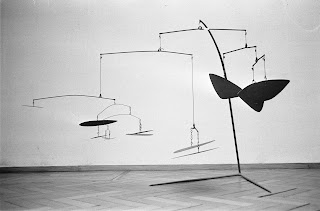Photo source: Wikimedia Commons, Eric Koch / Anefo, CC0 1.0
Alexander Calder (1898-1976) was an American sculptor best known for his mobile sculptures. The photo above is one of Calder's mobiles from 1969. Art curator James Johnson Sweeney said,
"Into the plastic expression of the period he has introduced a new element - that of time. In several of his mobiles he has, as it were, underscored certain suggested compositional rhythms by actual kinetic ones. And here his work offers an interesting parallel with that of the fountain sculptors, of the fifteenth and sixteenth centuries in Rome and Florence." (Alexander Calder's Mobiles, 1935)The rest of this post is some quotes from Calder.
Form and motion
"It is a matter of harmonizing these movements, thus arriving at new possibility for beauty." (It Shall Move - On Mobile Sculptures, 1932)
"How can art be realized? Out of volumes, motion, spaces bound by the great space, the universe. Out of different masses, tight, heavy, middling - indicated by variations of size of color - directional line - vectors which represent speeds, velocities, accelerations, forces, etc... - these directions making between them meaningful angles, and senses, together defining one big conclusion or many." (How Can Art Be Realized? 1932)
"Therefore, why not plastic forms in motion? Not a simple translatory or rotary motion but several motions of different types, speeds and amplitudes composing to make a resultant whole. Just as one can compose colors, or forms, so one can compose motions." (Statement form Modern Painting and Sculpture, 1933)
